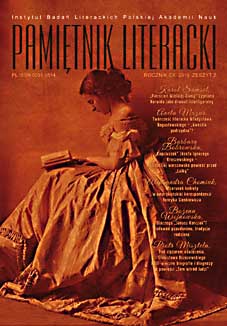Kim jest „rudobrody rzeźbiarz”?
Who Is “The Red-Bearded Sculptor”?
On the Short Story “Ad Leones!” once again
Author(s): Aleksandra SikorskaSubject(s): Polish Literature
Published by: Instytut Badań Literackich Polskiej Akademii Nauk
Keywords: Cyprian Norwid; Norwid’s “Ad leones!”; “Paris Salon 1881”; Venetian painting
Summary/Abstract: The article touches the problem of Venetian painting in such Cyprian Norwid’s pieces as “Menego”, “Salon Paryski 1881” (“Paris Salon 1881”) and the short story “Ad leones!.” When it comes to the origin of the second piece, he author of the paper finds the opinions by Theophile Gautier particularly valuable, especially those of them which refer to the issue of Venetian painting and the 19th c. continuators of the tradition. Philippe Beauassant’s book ”Passages, de la Renaissance au Baroque” (”Passages. From the Renaissance to Baroque”), the reading of which accompanied the author while producing the paper, allows to look at the consensus recorded in research tradition that the greyhound bitch accompanying the red-bearded sculptor best attests the virtues of the main character of “Ad leones!.” An effect of such readings is, according to the author of the paper, the opinion expressed by Dariusz Pniewski that “the sculptor was a few times named red-bearded and, which is equally important and even most important, he is accompanied by a dog, a greyhound.” It is for that reason that the researcher’s observations about Norwid’s attitude to Venetian colorism, though valuable, prove insufficient. The author of the paper attempts to reverse the tendency found in research in “Ad leones!,” trying to reach for the possible genesis of red-bearded sculptor’s creation. Employing this approach, the context of Venetian painting in the short story is extended by a possible iconographic inspiration as well as by a problem of mannerism (in its historical perspective) seen as a trend in the decline of the Renaissance, anticipating, in Norwid’s view, the tendencies in the art of his days. “Ad leones!,” written nearly at the end of the poet’s creativity, gains a double, symbolic frame of reference: Norwid’s reflection on the status of the artist, his predispositions and moral stance become also a view which embraces not only the 19th c., but also the end of the Renaissance.
Journal: Pamiętnik Literacki. Czasopismo kwartalne poświęcone historii i krytyce literatury polskiej
- Issue Year: 2019
- Issue No: 2
- Page Range: 115-132
- Page Count: 18
- Language: Polish

